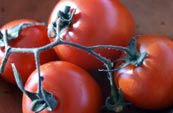 The tomato is ready to plant out once the first flower-bearing truss has formed.
The tomato is ready to plant out once the first flower-bearing truss has formed. - Watering the plants regularly will help to prevent the fruits' skin from splitting.
- When four trusses have set fruit, remove the growing tip to hasten ripening.
- Remove sideshoots: Using your thumb and finger, nip out any sideshoots that develop between the leaf and the stem to help channel the plant's energy into its fruits. Watering and regular feeding with a high-potash fertiliser will ensure a plentiful, healthy crop.
- Remove weed competition from around the tomato plants during the summer.
Pick the fruits when they are fully ripe, to capture all the flavour.
Wednesday, May 31, 2006
There's More to Tomatoes than in the Eating
Can Tomatoes Help Prevent Cancer?

Putting the romance of the western world's fourth most popular fruit (after bananas, apples and oranges) to one side, there's a lot more to tomatoes than just good looks and a great taste. Tomatoes contain virtually no fat and no cholesterol. They are very low in calories, typically only 10-15 kcals for a medium sized fruit, and are packed full of Vitamins A, C and E.
But it's the tomato's natural red pigment, lycopene, that has had the medical profession mooting its role as a "miracle fruit" most recently. The Cancer Research Campaign has recommened people increase the amount of fresh, ripe tomatoes they eat. Evidence suggests that a high intake of lycopene (an effective antioxidant ) can reduce the risk of cancer and other serious diseases.
Scientists have developed a genetically modified tomato which could be used to keep people healthy. They believe the fruit could even help to ward off heart disease and cancer.
Using gene technology they were able to increase levels of beneficial chemicals called falvonols in tomato peel.
Flavonols are powerful antioxidants, chemicals which fight disease by neutralising harmful oxygen molecules that circulate in the body, damaging tissues and accelerating the ageing process.
Some foods, such as onions and tea, are rich in these substances.
They are found naturally in tomato skin, but at much lower levels.
The British and Dutch scientists found that flavonol synthesis in the tomato is governed by an enzyme called chalcone isomerase.
An Irresistible Summer Tomato Tart - easier than all the wording it takes to tell you about it!!

Preparation time 30 mins
Cooking time 30 mins
Healthy and Gluton Free tart which would go well with a salad of rocket leaves or a good green salad. You might like to substitute goat's cheese or buffalo mozzarella for feta occasionally.
Ingredients: 2 red peppers, 1 tbsp extra virgin olive oil, 1/2 quantity of pastry or 9 inch bought pastry shell, rice flour, for dusting, egg wash, 175g/6oz feta cheese, 10 or more basil leaves, salt and freshly ground pepper, sugar (or balsamic vinegar) 8 tbsp tomato fondue (see below) 2-3 tbsp gluten-free pesto For the tomato fondue: 2 tbsp extra virgin olive oil, 110g/4oz onions, sliced1 garlic clove, crushed, 900g/2lb very ripe tomatoes, peeled, in summer, or 2½ x 400g/14oz cans tomatoes in wintersalt, freshly ground black pepper and sugar, to taste, 1 tbsp any of the following:freshly chopped mint or torn basil or a mixture of thyme, parsley, lemon balm and marjorama few drops of balsamic vinegar NB: This makes more than the required amount of tomato fondue. However, the remainder can be used as a sauce for pasta, a filling for omelettes, a topping for pizza or a base for bean stews.
Method1. For the tomato fondue, heat the oil in a heavy-based cast-iron or stainless-steel saucepan. Add the onions and garlic, toss until coated, cover and sweat on a gentle heat until soft but not coloured. It is vital for the success of this dish that the onions are completely soft before the tomatoes are added. Slice the peeled fresh or canned tomatoes and add with all the juice to the onions.2. Season with salt, freshly ground black pepper and sugar (canned tomatoes need lots of sugar because of their high acidity). Add the herbs. Cook, covered, for 10 minutes. Remove the lid and continue to cook for about 10 minutes more, or until the tomato softens. Cook fresh tomatoes for a shorter time to preserve the lively fresh flavour. 3. Add a few drops of balsamic vinegar at the end of cooking to greatly enhance the flavour.4. For the tart, preheat the oven to 250C/475F/Gas 9.5. First roast the red peppers. Place them on a baking tray and rub the surface with a little olive oil. Bake in the oven for 20-30 minutes, until they are soft and the skin blisters. Put them in a bowl and cover with cling film. Leave until cool enough to handle. Peel the peppers and remove the stalk and seeds but don't wash away the sweet juices. Cut into strips. 6. Reduce the oven temperature to 180C/350F/Gas 4.7. Make the savoury pastry following the recipe. Roll out the pastry on a very lightly rice-floured board. Line the tin with the pastry to a thickness of about 3mm/1/8in. Line to the top with parchment paper and fill with baking beans. Chill the pastry for a further 15-20 minutes and then bake the tart base blind for 15 minutes or until pale golden. 8. Remove the beans and paper, brush the tart shells with a little beaten egg and return to the oven for a further two minutes. This seals the pastry and helps to avoid a soggy bottom!9. Crumble the feta cheese using the tips of your fingers and spread half the cheese over the base of the pastry. Arrange a layer of roasted red pepper strips and basil leaves on top. Season with a little salt and freshly ground black pepper and a sprinkle of sugar or balsamic vinegar (take care when seasoning as feta is quite salty). Cover with eight tablespoons of tomato fondue and spread the remaining feta cheese over. 10. Return the tart to the oven for 10-15 minutes until it is hot and bubbly. Drizzle the tart generously with pesto and serve immediately. It is much more than yummy!!!
and yet ..... more tomatoes ... this one is easy peasy!!

Baked Tomatoes
Serves 4; Prep time: 10 minutes; Total time: 30 minutes
4 tomatoes, halved
1/4 cup finely grated Parmesan cheese
2 tablespoons plain breadcrumbs
1/2 teaspoon mixed dried herbs (thyme, marjoram, oregano, and basil)
1 tablespoon olive oil
1/4 teaspoon salt
1/8 teaspoon pepper
1. Preheat oven to 425°. Halve 4 tomatoes lengthwise; slice off a sliver from the skin side so that the halves lie flat in a baking dish.
2. In a small bowl, toss together 1/4 cup finely grated Parmesan cheese, 2 tablespoons plain breadcrumbs, 1/2 teaspoon mixed dried herbs (thyme, marjoram, oregano, and basil), 1 tablespoon olive oil, 1/4 teaspoon salt, and 1/8 teaspoon pepper. Mound mixture on top of each tomato half.
3. Bake until tomatoes are soft and topping is crisp and browned, about 20 minutes.
Per serving: 72 calories; 4.7 grams fat; 2.3 grams protein; 5.9 grams carbohydrates per serving
Thursday, May 18, 2006
The Firmament

That Nature hung in Heav'n, and filled their lamps
With everlasting oil, to give due light To the misled and lonely traveller. Milton
The most beautiful thing we can experience is the mysterious. It is the source of all true art and all science. He to whom this emotion is a stranger,who can no longer pause to wonder and stand rapt in awe, is as good as dead:His eyes are closed.
Albert Einstein
The word firmamentum means in classical Latin a strengthening or support. The firmament was the eighth sphere carrying the fixed stars, which surrounded the seven spheres of the planets in the geocentric model.
Gaak --- Artifical Intelligence

In June 2002, a robot called Gaak gave an alarming demonstration of its independence. It made a dash for freedom from an exhibit at the Magna science centre in Rotherham. Gaak crept along a barrier until it found a gap and squeezed through. Having left the building, it reached Magna’s exit by the M1 motorway before it was rumbled.
Just Love
Sunday, May 14, 2006
Happy Mother's Day and Thanks to Mitochondrial DNA
 "Where do we come from?" This has been one of the fundamental questions asked by humans for thousands of years.
"Where do we come from?" This has been one of the fundamental questions asked by humans for thousands of years.Physical anthropologists have been providing an answer for over a hundred years by studying morphological characteristics, such as skull shape, of the fossilised remains of our human and proto-human ancestors. For the last 15 years or so, molecular anthropologists have been comparing the DNA of living humans of diverse origins to build evolutionary trees. Mutations occur in our DNA at a regular rate and will often be passed along to our children. It is these differences (polymorphisms) that, on a genotypic level, make us all unique and analysis of these differences will show how closely we are related. However, different approaches used by molecular and physical anthropologists have led to opposing views on how modern humans evolved from our archaic ancestors. Mitochondrial DNA is present inside the nucleus of every cell of our body but it is the DNA of the cell's mitochondria that has been most commonly used to construct evolutionary trees.
Mitochondria have their own genome of about 16,500 bp that exists outside of the cell nucleus. Each contains 13 protein coding genes, 22 tRNAs and 2 rRNAs. They are present in large numbers in each cell, so fewer samples are required.
They have a higher rate of substitution (mutations where one nucleotide is replaced with another) than nuclear DNA making it easier to resolve differences between closely related individuals.
They are inherited only from the mother, which allows tracing of a direct genetic line.
They don't recombine. The process of recombination in nuclear DNA (except the Y chromosome) mixes sections of DNA from the mother and the father creating a garbled genetic history.
Happy Mother's Day and if you are saying it with flowers remember to thank your mothers for their Mitochondrial DNA and your genetic lineage.
Subscribe to:
Posts (Atom)
